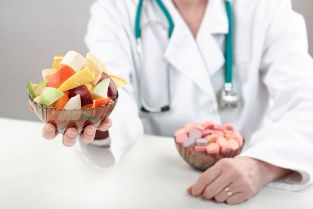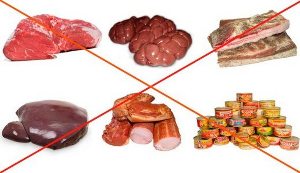Diet for gout is almost a first requirement, as the disease is associated with metabolic disorders. What foods can you eat if you have gout, which ones should not and which should be restricted?

Gout is a disease caused by metabolic disorders. It occurs when vein crystals - uric acid salts - accumulate in the joints. These crystals begin to form when uric acid levels are high in the blood - and this, in turn, occurs when the body produces too much of this acid, or the kidneys are unable to cope with it. In such cases, crystals similar to sharp needles begin to form in the joints and surrounding tissues. These needles cause pain, inflammation, swelling - generally, symptoms of gout. Often, deposits accumulate in the joints of the feet, especially in the toes.
Why is diet important for gout? It is simple: the body produces uric acid from purines, a chemical compound that is already present in it. But purines are found not only in the human body, but there are many products in certain products: for example meat and seafood. In addition, some types of food provoke the formation of uric acid, which means that the raw material for vein crystals is alcoholic beverages, especially beer, and even beverages with fructose - fruit sugar. If you are at risk (for example, you have kidney disease or you have hypertension) - with an improper diet, the chances of "getting" gout increase. If the disease is already diagnosed, it is only necessary to eat properly, otherwise the attack is inevitable.
Previously, it was believed that most men were at risk, but recently more and more women are getting sick, so it is important to follow a diet for both sexes. Diet for gout in women, as in men, significantly reduces the likelihood of worsening. At the same time, there is no difference in which joints are affected by the disease: it is important to follow a diet for gout on the legs and arms, and in general, changing eating habits is the main doctor's recommendation for the disease.

The purpose of this restriction is not only to reduce the use of purines and the intensity of uric acid production, but also to reduce weight if the patient has extra weight. The fact is that with obesity and even extra weight (of course, extra in the medical sense, its appearance has nothing to do with it), the concentration of uric acid in the body increases, and proper nutrition helps to lose both kilograms and these effects. Important: you should not "rush to all the bad" and lose weight with a tiring diet, it will only harm you, acid levels, on the contrary, will increase. It is better to get rid of excess gradually. Eat right and eliminate potentially harmful foods, and you will not be afraid of deterioration.
Dosage and Don't Forget to Gout: Food List
First of all, it is necessary to remove foods high in purine from the diet. In the end, if your body does not receive excess purines, then it will not produce excess acid from them, so why give it material for construction. There are many purines in products such as:
- Red meat. Sheep, beef, pork, beef are far from the best choices for gout sufferers. You can eat all of this, but the portion must be limited.
- Meat by-products. Liver, kidneys, brain, any "internal" flesh can cause irritation. Yes, all of this can be very tasty, but when a gout attack is on the other side - thank you, no.
- Games. Of course, he does not often appear on the table (well, if you or your partner are not avid hunters), but if you are suddenly offered to try exotic in the form of venison or grilled birds, refuse.
- Fish and seafood: purines just float in it. Cod, herring, trout, mackerel, sardines, tuna, plus crabs, shrimp, mussels and many other seafood can worsen the condition of a person with gout. True, some doctors believe that the benefits of seafood can outweigh the dangers, but only if it is eaten in moderation.
What better way to restrain yourself? The following foods have also been shown to increase the level of uric acid in the body:
- Sweet drinks: lemon juice and industrial sweet juices.
- Alcohol: Beverages based on beer and wheat such as vodka and whiskey. A little is possible, but if we discuss the diet for gout during exacerbations - at the moment it is not possible at all.
- Excess sugar: honey, agave syrup, other high fructose foods.
- Yeast additives.
- A semi-finished product (sometimes containing something incomprehensible).
Also, it would be better if you could skip the white bread, cakes and cookies. By themselves, they are not too harmful, but they do have few nutrients, and this also provokes the body to produce uric acid.
Of course, a steak or sandwich with liver pate will not cause an attack, the main thing is to follow a diet for gout and high uric acid.
What You Can Eat For Gout: Allowed Foods

We agree that the list of things to avoid from the diet is quite impressive, but that does not mean that you should only eat sunlight. Here are some foods you can eat for gout.
- Vegetables. You can eat anything, including a lot of purines (for example spinach) - it is not well absorbed from vegetables.
- Fruits and berries. Almost everything is possible, and some are necessary - it has been proven that cherries reduce the concentration of uric acid, which means that it is very useful as a nutritional component for gout.
- Beans. And again, lentils, soybeans, green beans, and green beans.
- Whole grains. Oats, brown rice, barley are just an example.
- Peanuts.
- Dairy products. In general, everything is much safer, but it is better to eat and drink where the percentage of fat is reduced.
- Eggs.
- Lean meats (chicken, turkey).
- Coffee, tea, green tea. There is research that shows that coffee does not significantly reduce the risk of gout, but too much coffee can lead to other health consequences, so it is best not to overdo it.
- Vegetable oils: coconut, olive, flaxseed.
- Any spices.
Very useful for gout or the tendency to drink as much as possible. Another suggestion is to take foods rich in vitamin C. Of course, this is not orange juice from the store, but orange or tea with lemon itself is good.
Diet for Gout: Diet
So what can and should not be eaten for gout? Based on the above, we have compiled a short list of products for you to check
Yes
- Vegetables
- Fruits and berries
- Beans
- Whole Grains
- Beans
- Dairy products
- Eggs
- Lean meats
- Coffee, tea, green tea
- Vegetable oil
- Any spices
Beware
- Red Meat
- Seafood
- Fish
- White bread, pastries
Rarely or never
- By-products
- Games
- Juice, lemonade
- Honey and other high-fat foods
- fructose
- Semi-finished products
- Alcohol
- Yeast Supplements
Of course, eating out gout implies that food from the "Carefully" column moves to the "Rarely or never" column. If the joint hurts, it is best not to overload it with extra storage, even the most insignificant.
Food for gout: menu
So, everything is clear with the products that are allowed and prohibited, but how to combine what is possible so that it is delicious and not often repeated? We have prepared a sample menu for you for a week and try to diversify it as much as possible until you have many options. Of course, you can make additions from the list of allowed products (and a few of the products used with caution).

Monday
Breakfast: green tea, "lazy oatmeal" with kefir or yogurt with berries. Simply pour kefir or yogurt on oatmeal with berries and leave in the refrigerator overnight. You will see, it is very tasty!
Lunch: Quinoa salad with boiled eggs and fresh vegetables, miso soup.
Dinner: Cereal pasta full of chicken and vegetables.
Tuesday
Breakfast: coffee, cottage cheese, peaches or a few slices of watermelon, bran.
Lunch: brown rice with grilled turkey.
Dinner: scrambled eggs with mushrooms and spinach.
Wednesday
Breakfast: vegetable salad, a handful of nuts.
Lunch: lentil soup with chicken soup.
Dinner: Burger (whole wheat bread, turkey pieces, cheese, vegetables).
Thursday
Breakfast: tea, yogurt with berries and bran grains.
Lunch: bean pilaf with chicken, vegetable salad.
Dinner: lean fish steak, garnished with green beans.
Friday
Breakfast: coffee, scrambled eggs with tomatoes and peppers.
Lunch: potato casserole with beef (alternate with chicken during the season).
Dinner: Fruit salad.
Saturday
Breakfast: milk, pancakes with low-fat sour cream.
Lunch: Roasted vegetables with chicken skewers.
Dinner: berry smoothie, some sandwiches with cheese and herbs (better take whole wheat bread).
Sunday
Breakfast: tea, whole grain milk porridge with berries.
Lunch: Lasagna (again, it is better to use whole wheat leaves as a base and minced chicken).
Dinner: julienne with chicken and mushrooms, homemade mulled wine based on berry compote (just add your favorite spices, apples and citrus fruits and heat).
As a snack, you can use vegetables, fruits and berries. Remember that cherries and citrus fruits are very useful, and it is also important to drink plenty of plain water. Dryness makes gout worse.
In general, it is easy enough to follow a diet for gout, the list of foods is quite large, and you can think of many combinations of them. Of course, it is easier to follow a diet in the summer because vegetables are cheaper and the variety is much higher. However, you can always notice the seasonal vegetables: for example, in September the watermelon season continues, in December the stores are full of pickled oranges, then it is replaced by pomelo. . . The same cherries can be frozen in summer and in winter it can be made into compote or pie (the latter is better not with spaghetti and sparse), and lemons are prepared throughout the year without restrictions.
Gout is not a death sentence, the prevalence of it can be significantly reduced if you eat well and control your uric acid levels. And even if you eat steak once a month and drink it with dark beer, it is unlikely it will cause an attack if you follow a diet.































